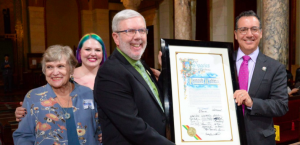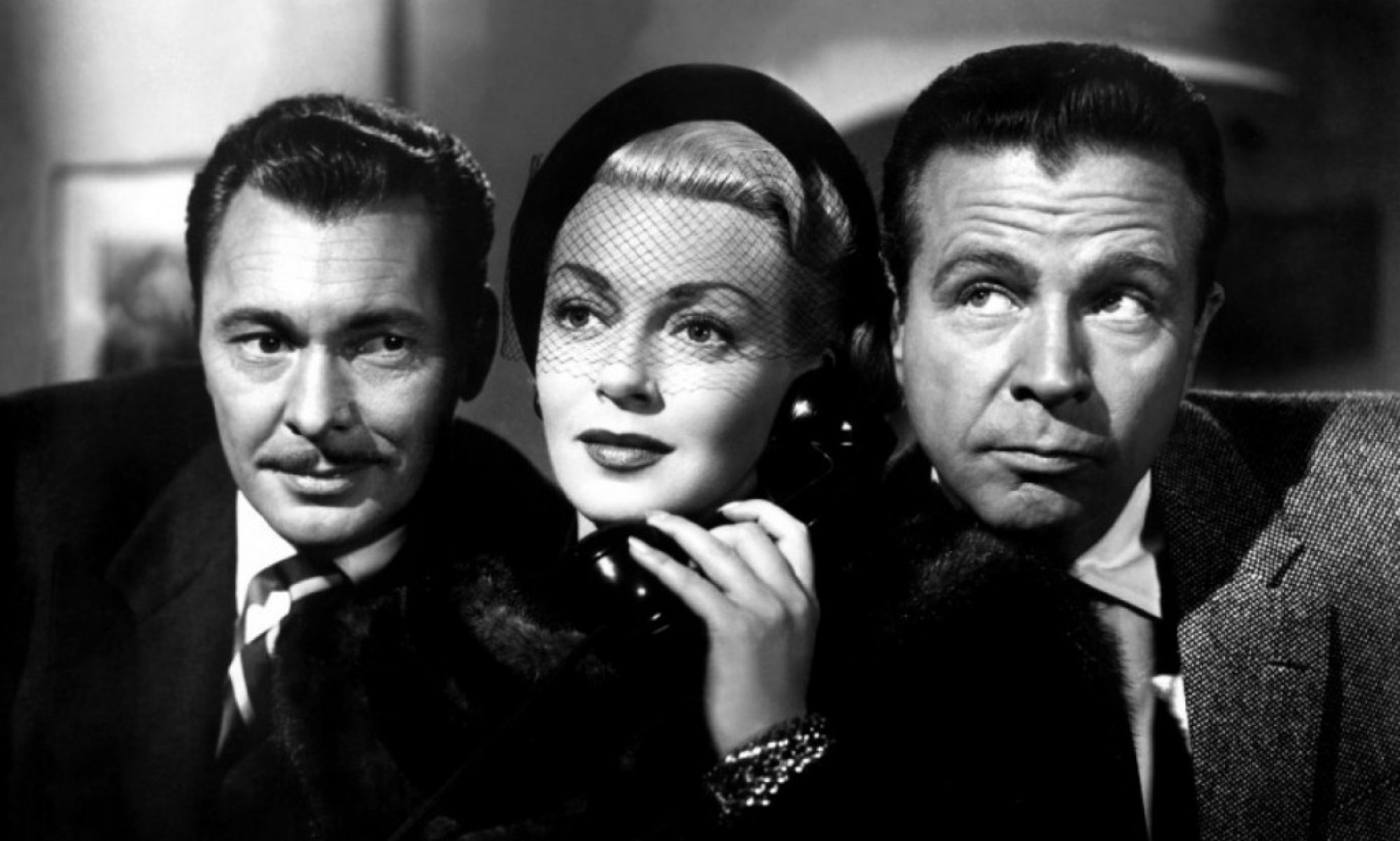In honor of “Leonard Maltin Day” in Los Angeles, here’s an interview I did with him in 1994 for the Bergen Record, part of a series called “Jersey People” that in wrote in the final months before I went back to work for the New York Post. This was at least the fourth interview I did with Leonard. The first was conducted in 1980, when he was still living in Manhattan, before moving to Los Angeles.

Leonard Maltin was a so-so student.
“I was the only student in the history of Teaneck High School to fail a take-home, open-book exam,” he says with a mixture of pride and embarrassment.
He also wasn’t much of an athlete.
“I went to the Westmont Swim Club’s day camp one summer, and I was the only one who was always rooting for a rainy day,” he remembered recently over brunch at his parents’ home in Teaneck.
Why a rainy day? Anybody who’s seen Maltin on “Entertainment Tonight” or read any of his two dozen books can probably guess the answer.
“Because then,” he said with a familiar smile, “they showed movies.”
And movies are what made Leonard Maltin a star.
The revenge of this self-described movie nerd has spread to virtually all media.
Maltin can be read, seen, or heard on radio, videocassettes, on-line services, and CD-ROM. Last month, the 25th-anniversary edition of his landmark movie guide was published, complete with new versions for floppy disc and the Apple Newton. “Leonard Maltin’s Movie Encylopedia” hits bookstores this month, and he has a special on Canadian animation airing Oct. 27 on the A&E cable network.
“My son has been very, very lucky,” said Maltin’s father Aaron, a retired immigration judge. “He has spent his entire life doing exactly what he wanted to do.”
Maltin’s mother Jacqueline, a former nightclub singer, remembered with a chuckle that back in the 1950s, she tried to pry her pre-adolescent son (he’s now 43) away from TV, where he had developed an early infatuation with Laurel and Hardy, the Three Stooges, and Disney cartoons.
“Why do you want to stay indoors on such a beautiful day?” she remembered asking him over and over, to little avail. “I wasted a fortune on tennis lessons for him.”
Young Leonard dabbled in journalism as early as the fifth grade at the Eugene Field Elementary School, publishing a three-page newspaper called the Bergen Bulletin on a mimeograph machine. Early issues contained cartoons and jokes — but Leonard being Leonard, it quickly evolved into a newsletter about movies.
By the time he was 13, Maltin was conducting interviews by mail with celebrities such as Buster Keaton and writing articles for Film Fan Monthly, an amateur “fanzine” published in Vancouver. He wasn’t paid. Two years later, he “bought” the magazine for $175.
“The owner had $400 in the treasury, so he sent me a check for $225, a bunch of back issues, and the list of 400 subscribers,” he recalled.
Maltin published Film Fan Monthly out of his parents’ house virtually single-handedly from 1966 to 1974.
“That was the end of my ability to do anything in school,” said Maltin, who somehow graduated from New York University with a journalism degree, handing in freelance assignments as class papers. He then taught — film, what else — for nine years at the New School for Social Research in Manhattan. He went on to curate programs at the Museum of Modern Art.
But back in the early 1960s, Maltin was thoroughly immersed in the cult of amateur film collectors who showed battered 16mm films in their homes and other rented spaces. You were allowed to bring your friends, but the main point of etiquette was that the invitees were obliged to stay until the end of the movie, no matter how awful.
“Remember that terrible Joel McCrea movie you made me sit through?” Jacqueline Maltin asked her son, recalling a trip perhaps 30 years ago to a seedy screening room behind the Port Authority Bus Terminal, which occasionally was raided by police looking for porno movies.
” `The Great Moment,'” her son replied.
“He said, `But Mom, we can’t leave. I pleaded. But he wouldn’t let me leave.”
On other occasions, Maltin and his friends would attend screenings at the East Rutherford home of John Griggs, a crotchety old character who had amassed a formidable collection of silent movies.
“One night, he had rented `Mutiny on the Bounty’ and it was getting quite late. It was past our curfew, and I had to call for my mother to pick us up.
“He was beside himself. He finally said, `All right, go. But you haven’t even seen the mutiny.'”
Maltin also created a film society at Teaneck High School, “renting from a guy and his mother out of their home in Fair Lawn. Their most expensive rental was $15, and they had a $4 budget line that included titles like [Alfred Hitchcock’s] `The 39 Steps.’ My friend Louis said, `Gee, that’s 10 cents a step! ”
Maltin’s obsession did not escape the notice of the faculty. An English teacher introduced him to an editor he knew at the New American Library (now Signet), who was so impressed with his knowledge that he signed the 17-year-old to write his movie guide, originally known as “Movies on TV” and now known as “Leonard Maltin’s Movie and Video Guide.”
Though he later wrote books on Disney cartoons and other movie subjects, it was this comprehensive guide that put him on the map — at least among movie buffs, who have been known to read the thick paperback on the subway or in bed. (The new edition covers 19,000 titles in its 1,580 pages, compared with 8,000 in the original.) It has become a standard reference work, used by most newspapers (including this one) and magazines in the United States, as well as in the movie and
television industries.
The various editions have sold more than 4 million copies.
“That might sound like a lot,” said the modest Maltin. “But around the time we broke the 100,000 mark, the movie-tie version of `The Omen’ sold 3.25 million copies. That sort of puts it in perspective.”
Maltin attributes the book’s enduring popularity (and a raft of imitators) to two events that occurred more or less simultaneously. They were his hiring toward the end of the first season of “Entertainment Tonight” in 1982 and the rise of home video, which eventually made thousands of movie titles available for sale and rental — and made his book all but indispensable, even for people who didn’t watch “The Late, Late Show.”
“Suddenly, my publisher was on the phone, wanting to put my name above the title and my picture on the cover. Before `E.T.,’ I could have got down on my knees and begged and they wouldn’t have done that.”
With his bespectacled, bearded, ordinary-guy looks, Maltin may not be as glitzy as the rest of the “E.T.” crew. But he is the senior surviving cast member; Mary Hart joined the show a few weeks after him. During most of his tenure, he has functioned as a film historian. But recently the show, which has been extensively revamped in recent weeks, asked him to review movies for the first time in seven years.
“It’s not something I was prepared for, or particularly wanted to do,” he says. “But this show has always been reinventing itself. I’ve been through seven different producers, a couple of whom wanted to get rid of me.”
While “E.T.” is Maltin’s home base, he frequently works at home. He and his wife, Alice, who has functioned as his producer for several TV documentaries, have plenty to keep them busy besides their 8-year-old daughter, Jessica.
Maltin, who co-authored a book on “The Little Rascals” 20 years ago with Richard W. Bann (recently reissued to tie in with the movie remake), was commissioned last year to do the introductions for a series of restored “Our Gang” comedies. They’re on the video sales bestseller list — not bad for 60-year-old shorts that Maltin said Blockbuster Video, the nation’s largest chain, wouldn’t even stock.
Maltin, who lives in Los Angeles but visits Teaneck several times a year, observes that being the country’s best-known movie nut “mostly feels nice.”
As with any celebrity, sometimes people take potshots at him. A profile of filmmakers Joel and Ethan Coen in Playboy magazine this spring began with a lengthy contemplation of his derriere. He happened to be interviewing the Coens just before the Playboy writer.
“What story was that?” his mother interrupted when the subject was broached.
“Tell you about it later, Mom,” Maltin said, turning back to the interview.
“At first I was upset,” he said with a smile. “Then the engineer for my radio program found this story in one of the supermarket tabloids with the headline, `The Bigger Your Butt, the Smarter You Are.’ So I cut it out and sent it to Hugh Hefner.”
Mainly, though, Maltin views his celebrity as a means to meet the bigger, invariably older celebrities he still idolizes with the zeal of a 15-year-old. His eyes opened wide as he recounted recently attending a birthday party for Clayton Moore, TV’s Lone Ranger. The guests included legendary cowboy star Gene Autry, who told Maltin about a 26-city tour he undertook to promote one of his films.
“He would stay in a different city every night and arrange to receive the keys to the city from the mayor and be interviewed by the local paper early in the morning. He made sure the stories appeared in that night’s paper. After that, I wasn’t going to complain about my little book tours.”
Is Leonard Maltin interested in anything but movies?
He plays the piano, and he and his wife occasionally tear themselves away from at-home screenings — 16mm, not video, is the preferred medium — to frequent Los Angeles jazz clubs. (His brother, Bud, who also lives in Teaneck, has his own jazz band.)
“And once in a while, I manage to sneak a jazz piece onto `E.T.'”
Adds his father: “Sometimes he takes me along, and I get to meet people like Steve Allen. It’s a very nice perk of being Leonard’s father.”
Asks Leonard: “How can you put a value on experiences like that? It’s like living in Disneyland.”
